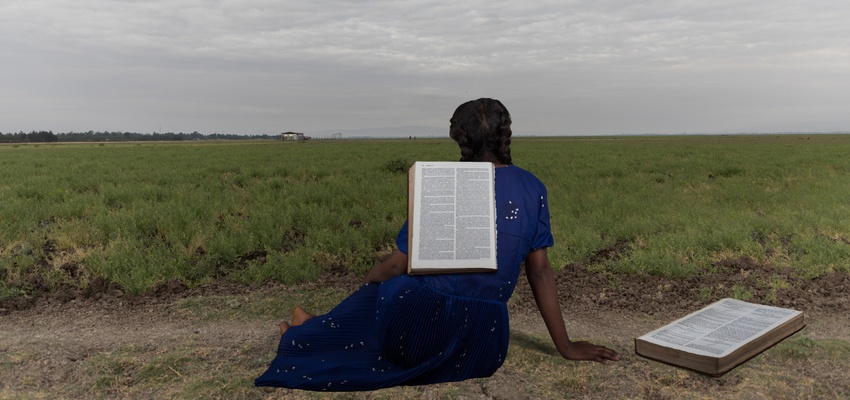The full series includes 38 photos by photographers from seven African countries; through fine art and documentary photography, the artists highlight the weight of NTDs on individuals and communities, using art as a tool of shared human emotion while addressing the need to spread awareness of neglected diseases.
The END Fund mobilizes resources for NTDs and focuses on delivering treatments to those in need by growing and engaging a community of activist-philanthropists, managing high-impact strategic investments, and working in collaboration with government, NGO, pharmaceutical, and academic partners.
To celebrate ten years of impact, the END Fund engaged Muluneh to create a body of work with photographers from across six countries in Africa impacted by NTDs: Ethiopia, Somalia, Kenya, Mali, Nigeria, and Sudan. Reframing Neglect includes photography by Messeret Argaw (b. Ethiopia, 1989), Mustafa Saeed (b. Somalia, b. 1986), Sarah Wasiwa (b. Uganda, 1980), John Kalapo (b. Mali, 1983), Omoregie Osakpolor (b. Nigeria, 1990) and Ala Kheir (b. Sudan, 1985).
The collection will be showing in partnership with The Africa Center, Harlem, before traveling to Cromwell Place London.
Please note that the exhibition will be staged as follows:
Gallery 12, Wing Gallery: 27 September - 1 October, 2023
Gallery 12: 4 October - 8 October, 2023
As the END Fund continues to seek partnerships that elevate the voices of the communities in which they operate, Reframing Neglect serves as a testament to impactful storytelling and speaks to the urgency with which we must collectively act to address the burden of these neglected diseases and the impact they have on communities.
Muluneh comments ‘NTDs are a group of treatable, preventable diseases that needlessly hold back the lives and livelihoods of 1.7 billion people, a disproportionate number of whom are women and girls. Art has the capacity to shift perceptions, complementing more traditional modes of advocacy. My hope is that this collection helps educate and inspire audiences to action for NTD elimination while also sharing an African perspective through the work of myself and the other photographers featured in the collection.’
Sam Mayer, Vice President of Public Affairs at the END Fund, comments: ‘We’re thrilled to be able to showcase this important work in New York and London, where the culture of art and imagery is so rich. Storytelling has long been used as one of the most powerful communication tools to educate, unify, and spur action. Reframing Neglect is a wonderful example of this from a new series of storytelling partnerships that allows the END Fund and our partners to increase awareness of NTDs and the needless impact they have on millions of people across Africa and beyond. Our work with Muluneh emphasizes our priority to amplify the narratives of storytellers that are representative of the communities we work with, upholding our collective commitment to fundamental human dignity, and highlighting the impact of our programs with fuller and more authentic perspectives.’
About the artists
Muluneh embeds multiple layers of narrative into each image to create a powerful interpretation of the impacts of NTDs on gender equity, mental health, mobility, and access to resources. Using bright colors and respect for tradition as her vehicle, Muluneh’s work dismantles renderings of a bleak and impoverished Africa. In her latest collection on view, titled The Crimson Echo (2021), Muluneh uses motifs of both insects (‘The Barriers Within’) and abstracted body parts (‘I Sail on The Memories of My Dreams’), which lend specific attention to the disease vectors and physical manifestations of NTDs that are often overlooked.
Sudanese photographer, Ala Kheir, layers photos of people and places in his series. Kheir highlights a neighborhood on the outskirts of Khartoum known as the Stables Industrial Area, where families who flee unstable regions have made makeshift homes. His work highlights the people forced to find refuge in places that are not suitable to be homes. These new neighborhoods have sprouted in the peripheries of the city, and it is where the majority of people living with NTDs reside.
Sarah Waiswa, a Ugandan-born, Kenya-based photographer, follows Eunice Atieno, a 48-year-old single mother who for 11 years has been living with lymphatic filariasis (LF), a disease caused by parasitic worms that is the leading cause of permanent disability worldwide. In its advanced stage, the disease leads to complications of swollen legs with rough, thickened skin and can occur in other parts of the body, including the scrotum. In 2019, Eunice was diagnosed with LF following a mass drug administration exercise that took place in her neighborhood.
Somali documentary photographer and visual artist, Mustafa Saeed, focuses on dissecting the emotional turmoil that intestinal worms have on people impacted. Through colorful ropes and garments, Mustafa conveys the neglect and feeling of imprisonment from a disease that can easily be treated.
Malian photographer, John Kalapo, documents people living with NTDs in the Kita region of the country. Through formal portraits, he captures the physical impact of the disease while maintaining the dignity of the people he photographs. He focuses on documenting cases of river blindness and LF in the villages of Sagabary, Boukarybaye-Bohan, and Kita town.
Ethiopian photographer, Meseret Argaw, explores the social, economic, and mental health impact NTDs have on women living in rural communities in Ethiopia. Through conceptual pieces, she illustrates how NTDs force women into cycles of poverty.
Omoregie Osakpolor is an emerging documentary photographer living in Lagos, Nigeria. In this series, he documents the activities of END Fund partner, the Amen Foundation, which works on NTDs in Gombe, Nigeria. Nigeria has one of the highest rates of NTDs in the world, with over 166 million people at risk. The series illustrates the physical impact of NTDs on patients and how health workers are tackling the group of diseases in their communities.





